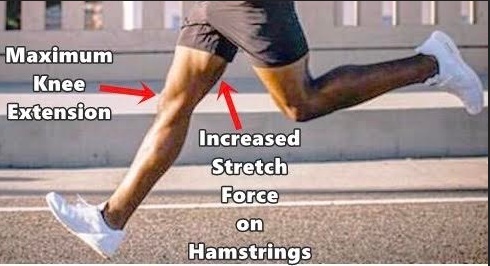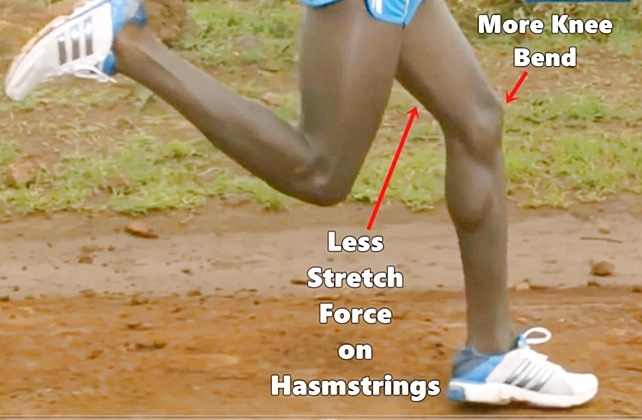One reason heel strike running is unsustainable for injury prevention is that it causes higher rates of tension and compression on the hamstrings as compared with forefoot running.
In many cases, landing heel-first during running is often accompanied by maximum knee extension (fully unbent knee) at touchdown (shown below). This produces an over-stride which means the initial foot-strike position (i.e the extended leg) is positioned too far ahead of the mass of the body. The major problems with this is 1. the mass of the body collides too intensively with the extended leg at touchdown and 2. the mass of the body collides with the extended leg for a prolonged period of time, too! A consistent consequence of this scenario is that a compressive wave is produced which ripples up the leg, through the hips.


Even worse, the collisional force, and therefore compressive wave, increases in proportion to speed and body-weight during running. In other words, the faster you run and/or the more you weigh, the greater the intensity and duration of the collisional force and compressive wave when you run with an over-stride coupled with landing heel-first. How can hamstring injury arise out of all this?
For one, a fully extended leg (maximum knee extension) at touchdown during running stretches the hamstrings beyond maximum tension during the phase of running (i.e touchdown phase) associated with the greatest production of impact.

Multiple lines of research (listed below the article) speculate that this landing configuration under these high-impact conditions during running easily causes hamstring injury because of the increased time the hamstrings spend in a maximally stretched state. The other concern is the over-stretched hamstrings spend an increased amount of time enduring high impact. As a result, microscopic muscle damage to the hamstrings easily arise, and hamstring injury can manifest in this one way.
In contrast, the hamstrings are more safeguarded from injury in forefoot running because landing forefoot-first during running results in a less extended leg, and therefore less knee extension at touchdown (shown below). This contributes to a shorter stride, thus over-striding is prevented. Because there’s less knee extension at touchdown in forefoot running, the hamstrings stretch less which reduces tension on them as well.
Even better, the reduced stride length in forefoot running accounts for a big reduction in the collisional force, therefore less compressive loads are transmitted to the hamstrings, too!

Making the conscious effort of landing on the balls of the foot during running causes the knee to slightly bend which effectively reduces stretch force and tension on the hamstrings. Even better, the increased knee-bend at touchdown in forefoot running enables the foot to land closer to the mass of the body, reducing the brake force low enough to avoid a high compressive wave.

Ultimately, these are good reasons forefoot running can easily reduce your risk of hamstring injury risk as compared with heel strike running. To that point, there’s a long-list of other injuries forefoot running prevents than heel strike running. Read more about it here!
References:
Goss DL and Gross MT. A review of mechanics and injury trends among various running style. AMEDD, Sept -2012.
Heiderscheit B.C., Hoerth D.M., Chumanov E.S., Swanson S.C., Thelen B.J., Thelen D.G. Identifying the time of occurrence of a hamstring strain injury during treadmill running: a case study. Clin. Biomech. (Bristol., Avon.) 2005;20:1072–1078. doi: 10.1016/j.clinbiomech.2005.07.005
Opar D.A., Williams M.D., Shield A.J. Hamstring strain injuries: Factors that lead to injury and re-injury. Sports Med. 2012;42:209–226. doi: 10.2165/11594800-000000000-00000.
Schache A.G., Kim H.J., Morgan D.L., Pandy M.G. Hamstring muscle forces prior to and immediately following an acute sprinting-related muscle strain injury. Gait Posture. 2010;32:136–140. doi: 10.1016/j.gaitpost.2010.03.006.
If you’d like, you can support Run Forefoot and help keep it going by making a donation in any amount of your choosing:

Or, you can also support Run Forefoot by shopping at the following top minimalist shoes brands, and be sure to bookmark the links:
Be Lenka: https://www.dpbolvw.net/click-7600968-14330828
FeelGrounds: https://www.feelgrounds.com/?p=RunForefoot
Xero Shoes: https://xeroshoes.com/go/Run_Forefoot
Iguaneye: https://www.iguaneye.com/?ref=8tfXVc92
Soft Star Shoes: https://shrsl.com/3mp1b
Wilding Shoes: https://bit.ly/3lIygQP
Earth Runners: https://earthrunners.com/?rfsn=6763579.f7f9c9
Vivobarefoot: https://shrsl.com/3kvih
Zappos: https://goo.gl/J1CeAd
Bretta Riches
BSc Neurobiology; MSc Biomechanics candidate, ultra minimalist runner & founder of RunForefoot. I was a heel striker, always injured. I was inspired by the great Tirunesh Dibaba to try forefoot running. Now, I'm injury free. This is why I launched Run Forefoot, to advocate the health & performance benefits of forefoot running and to raise awareness on the dangers of heel striking, because the world needs to know.
Latest posts by Bretta Riches (see all)
- Can You Run In Barefoot Shoes? Yes, But DON’T Heel Strike! - 21/07/2024
- Why Cushioned Running Shoes Are Really Bad for Your Feet - 19/07/2024
- Do Cushioned Running Shoes Cause Injuries? - 17/07/2024

